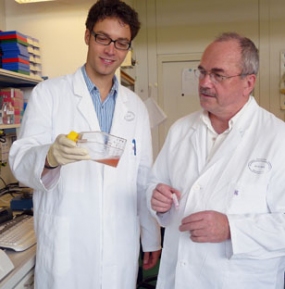New Test for Safer Biomedical Research Results
In biomedical research with living cells in the culture dish, contamination with bacteria, viruses or other fast-growing cells is always a problem. Scientists of the German Cancer Research Center (Deutsches Krebsforschungszentrum, DKFZ) have now developed a test system for fast and cost-effective detection of such contaminations. The new method will contribute to making biomedical research results safer and reproducible.
In cancer research, as in most other biomedical sciences, they are playing a key role: living cells, kept in sterile plastic containers with red culture media populating incubators in laboratories around the world. But do researchers always know what is really living in their culture dishes? Under the microscope, different cell lines are almost impossible to distinguish from each other. When these important research objects stop growing without apparent reason – is it because of the manipulations by the scientists or because of an invisible viral or bacterial infection?
Contaminations with other cell lines or pathogenic agents are a common and well-known problem. Often they are the reason why cell experiments fail to produce useable or reproducible results. Even worse, laboratory staff can get infected with dangerous pathogens from a cell culture.
To make those important cell culture experiments safer, DKFZ researchers Dr. Markus Schmitt and Dr. Michael Pawlita have developed a test which is able to identify 37 different cell contaminations in a single run. The researchers have tested the system in over 700 samples from different research labs and have now published their results.
The method called “Multiplex cell Contamination Test” (McCT) detects not only wide-spread viruses but also a number of mycoplasmas, which are considered the major contaminators of cell cultures. In addition, the test checks the cells for their origin. Thus, if dog genetic material is found in what are supposed to be monkey cells, then a contamination of the cell culture is obvious. The test also includes detection of commonly used standard cell lines. Contamination with the fast-growing cancer cell line HeLa, for example, is a dreaded source of false results.
Pawlita and Schmitt found contaminations in a high percentage of cell samples. Twenty-two percent of tested cultures were contaminated with one of the various types of the parasitic bacterium called mycoplasma. “What we noticed about the results,” says Markus Schmitt, “was that contaminations were frequent in some laboratories, while others sent in cultures that were constantly clean. Thus, care in laboratory work seems to play an important role.“
The test is highly specific and needs no more than ten copies of foreign DNA in the cell sample to be positive. This is a sensitivity which is comparable to or even higher than those of previously available commercial mycoplasma tests. McCT results are reproducible to 99.6 percent. The method is based on multiplication of specific DNA sequences by polymerase chain reaction and subsequent detection of the multiplied DNA regions. A special advantage of the new test is that it can be carried out on a high-throughput basis. The DKFZ researchers can manage up to 1,000 tests per week.
Schmitt und Pawlita offer the service to external scientists and research institutes via the Steinbeis Transfer Center “Multiplexion“, a DKFZ spin-off. If you are interested, please visit www.multiplexion.com for more information about the conditions.
Markus Schmitt und Michael Pawlita: High-throughput detection and multiplex identification of cell contaminations. Nucleic Acids Research 2009, DOI: 10.1093/nar/gkp581
With more than 3,000 employees, the German Cancer Research Center (Deutsches Krebsforschungszentrum, DKFZ) is Germany’s largest biomedical research institute. DKFZ scientists identify cancer risk factors, investigate how cancer progresses and develop new cancer prevention strategies. They are also developing new methods to diagnose tumors more precisely and treat cancer patients more successfully. The DKFZ's Cancer Information Service (KID) provides patients, interested citizens and experts with individual answers to questions relating to cancer.
To transfer promising approaches from cancer research to the clinic and thus improve the prognosis of cancer patients, the DKFZ cooperates with excellent research institutions and university hospitals throughout Germany:
The DKFZ is 90 percent financed by the Federal Ministry of Education and Research and 10 percent by the state of Baden-Württemberg. The DKFZ is a member of the Helmholtz Association of German Research Centers.


